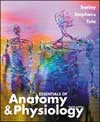 |  Essentials of Anatomy & Physiology, 4/e Rod R. Seeley,
Idaho State University
Philip Tate,
Phoenix College
Trent D. Stephens,
Idaho State University
The Heart
Study OutlineThe Cardiovascular System(Fig. 12.1, p. 312)Functions of the Heart(Fig. 12.2, p. 313)Generating blood pressureClinical Focus: Conditions and Diseases Affecting
the Heart p. 329
Routing blood
Ensuring one-way blood flow
Regulating blood supply
Size, Form, and Location of the Heart(Fig. 12.3, p. 314)Anatomy of the Heart
Pericardium(Fig. 12.4, p. 315)Fibrous pericardium
Serous pericardium
Parietal pericardium
Visceral pericardium (epicardium) Pericardial cavity and fluid
External anatomy(Fig. 12.5a, p. 315)
(Fig. 12.5b, p. 316 - surface view)Sulci
Veins
Arteries
Blood supply to the heart(Fig. 12.6, p. 316)Coronary arteries
Cardiac veins
Heart chambers and internal anatomy(Fig. 12.7, p. 318)Atria
Ventricles
Septa
Major vessels
Heart valves(Fig. 12.8, p. 318)Atrioventricular
Tricuspid
Bicuspid (mitral) Semilunar
Pulmonary semilunar
Aortic semilunar
Papillary muscles and chordae tendinae(Fig. 12.9, p. 319)Skeleton of the heart(Fig. 12.10, p. 319) Route of Blood Flow through the Heart(Fig. 12.11, p. 320)Entry
Exit
Heart Wall and Cardiac Muscle(Fig. 12.12, p. 321)Heart wall
Epicardium (visceral pericardium)Myocardium
Endocardium
Cardiac muscle(Fig. 12.13, p. 315)Cells, myofibrils, myofilaments, and sarcomeres
Intercalated disks and gap junctions
Electrical Activity of the Heart
The action potential
Comparison of skeletal and cardiac muscle(Fig. 12.14, p. 322)Plateau phase and voltage-gated Ca2+ channels
The refractory period
Spontaneous activity in SA node
Conduction system of the heart(Fig. 12.15, p. 324)SA node (pacemaker)AV node
Atrioventricular bundle
Left and right bundle branches
Purkinje fibers
Electrocardiogram(Fig. 12.16, p. 324)P wave
QRS complex
T wave
P-Q (P-R) interval
Q-T interval
Cardiac arrhythmias(Table 12.1, p. 325) Cardiac cycle(Fig. 12.17, p. 327)Atrial systole and diastole
Ventricular systole and diastole
Events of a single complete cycle
Heart Sounds(Fig. 12.18, p. 328)First heart sound
Second heart sound
Murmurs
Incompetent valves
Stenosed valves
Regulation of Heart Function Clinical Focus: Treatment and Prevention
of HeartCardiac outputDiseasep. 333-34
Intrinsic regulation of the heart
Preload and afterload
Starling's law of the heart
Extrinsic regulation of the heart(Fig. 12.19, p. 331)Sympathetic and parasympathetic
Baroreceptor reflex(Fig. 12.20, p. 332)Cardioregulatory center
Epinephrine and norepinephrine
Chemoreceptors in medulla oblongata(Fig. 12.21, p. 333)Emotions
Ions
Body temperature
Systems Pathology - Myocardial InfarctionSystems Interaction Table
|
|



 2002 McGraw-Hill Higher Education
2002 McGraw-Hill Higher Education